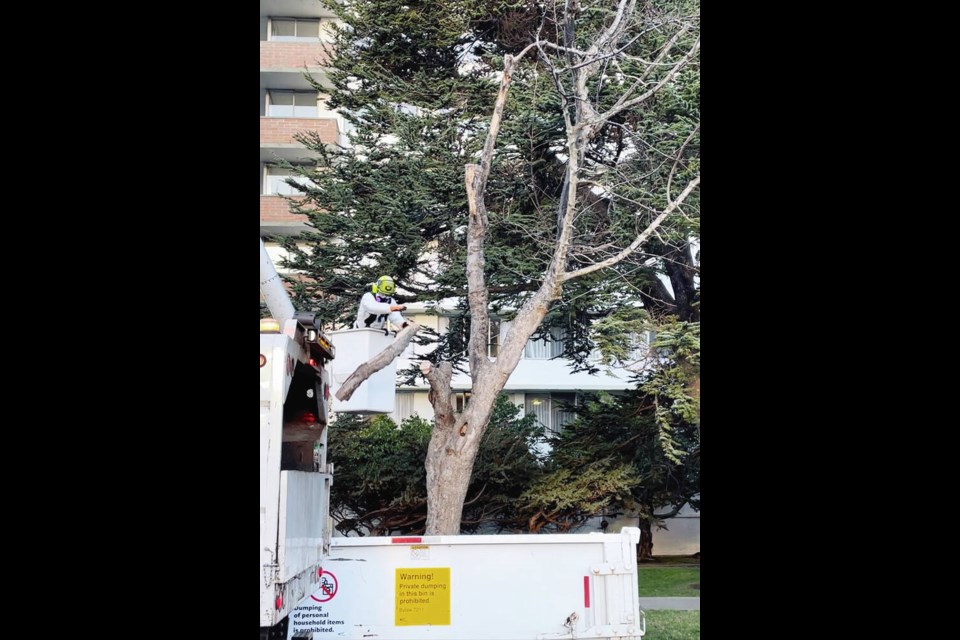City workers in white protective suits and masks carefully carved up a sycamore maple tree in James Bay this week.
The branches and pieces of trunk were placed in steel boxes and taken to the landfill for burial.
The 40-year-old tree on South Turner Street was infected with sooty bark disease, an aggressive fungus first discovered in Victoria in 2022 and now in danger of sweeping through and killing sycamore and Norway maple trees in the region.
Scientists at the Pacific Forestry Centre said about 30 of the imported ornamental maples in Victoria and at least one in Saanich are known to have the fungus, which resembles a dark brown soot that attacks the wood and can quickly kill the tree.
But it’s believed many more in the region have the disease. In Victoria alone, which keeps a detailed tree inventory, there are 432 sycamore and Norway maple trees. The species were planted to line city streets and boulevards.
The fungus, which infects the tree’s living tissue, can become fatal as a result of the prolonged droughts and heat waves associated with climate change, said Joey Tanney, a research scientist at the Pacific Forestry Centre.
Though sooty bark disease was first identified in 1899 in London, Ont. and discovered in England in 1945, the fungus is a newcomer to British Columbia.
Tanney and research colleague Nicolas Feau first got the heads up from scientists in Pullman, Washington in 2020 and it was discovered on the Lower Mainland after the infamous heat dome of 2021.
Tanney said trees may have the fungus and be asymptomatic for years, but when temperatures rise for prolonged periods, it can kill a maple within months.
“It’s like a ticking time bomb,” said Tanney. “You have the host and you are just waiting [for the heat and drought] for the fuse to be lit.”
Feau watched a sycamore maple on Moss Street go from a healthy tree to wilting leaves, lost branches and cracked trunk within about six months last summer when Victoria went weeks without rain.
Tanney said the fungus is prolific — and it gets airborne during dry spells to easily spread.
He said one centimetre of infected bark can have up to 170 million spores and a single five-metre maple could host up to 50 trillion.
It spreads to other trees through “wounds,” said Tanney, which can include pruning, weed whackers, vehicle strikes and even squirrel damage.
The spores won’t hurt people walking by or living near infected trees but can be highly allergenic for those working closely with the wood, such as arborists.
That’s why city workers used full protective gear and wetted the trees when cutting down the maple in James Bay. Cut tree logs are sometimes left for homeowners, but not the infected wood, because of the danger of spreading the spores.
The risk now, according to Feau and Tanney, is seeing if sooty bark disease will spread to endemic maples such as the broad leaf and vine species in 小蓝视频
Tanney and Feau said they have started a greenhouse experiment at Natural Resources Canada’s Pacific Forestry Centre to see if broad leaf and vine maples are susceptible to the sooty bark fungus.
The results are expected to be seen within a year, said Tanney.
Tanney and Feau said they are relying on citizen scientists to help identify just how far the fungus has spread.
They set up an interactive page on iNaturalist at so people can post photos of trees they think are infected with sooty bark disease.
“I personally feel we shouldn’t be planting [sycamore and Norway maples] anymore,” said Tanney, adding more drought-resistant and native trees such as Garry oaks would be better choices.
He said as more intense and prolonged heat waves continue, more maple trees will be killed by the fungus.
>>> To comment on this article, write a letter to the editor: [email protected]




